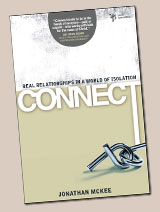
Last month a student from the high school just down the street from me excused himself from class about 10:15 a.m., walked into a restroom, and shot himself.
It was his 17th birthday.
My heart sank as I read the entire story in our local Sacramento paper. That’s the third article this week I’ve seen about teenage anxiety, depression, violence, and self-injury. Anyone in contact with youth notices their stress, pain, and emptiness.
As youth workers, we read books to try to understand a youth culture that seems to be growing more relationally disconnected and distant. Book titles like Hurt and Helping Teenagers in Crisis are becoming more commonplace. Young people are in pain, and they are seeking others who can identify with those feelings.
Ironically, this generation that feels so “alone” is looking for comradery in the wrong place… seclusion. The Friday night hangout is drifting away from a physical place with living, breathing bodies. Alone, in the privacy of their own bedrooms, kids flock to virtual hangouts and encircle themselves with e-friends-surrounded, yet isolated.
Technology allows young people to instantly connect to others digitally while staying geographically isolated from them. Their favorite social networking site brags several hundred friends-yet somehow they still feel alone. The tools that are supposed to cultivate connection leave students wanting more-and for good reason. E-friends can’t fill the tangible, relational void in students’ lives.
Whether realized or not, all of us long for face-to-face relationships.
We need them.
Recently, artist Evan Baden created a series of photographs called The Illuminati, depicting current children and teenagers in a common light–the glow of their electronic devices on their faces. Baden’s words describing the photographs are almost more revealing than the pictures themselves:
Considering the increase in time spent communicating, one might assume technology helps young people build deeper relationships. However, statistics show us quite the opposite. Students and young adults have fewer close friends than their peers of just a decade ago. I believe the lack of face-to-face time is dissolving relationships, and wounds from this are beginning to emerge in the lives of teens all around us.
As I write this chapter, I’m traveling on a plane that just left Chicago. During takeoff I picked up the airline’s magazine, flipping through the magazine I noticed an advertisement for a dating service. It read:
The need for face-to-face relationships is becoming so readily apparent that even advertising targets this felt need.
Studies are also showing youth and young adults are participating less in team sports and more in individual activities:
-
- Since 1998, the number of young adults participating in team sports has decreased from 19 percent to 13 percent.
- The number of young adults going out to the movies has decreased from 13 percent in 1998 to just 3 percent in 2008.
- The number of adolescents staying home to watch television or rent videos has increased from 24 percent in 1998 to 32 percent in 2008.
It seems to me students today are more isolated, have fewer close friends, and are drifting away from activities with personal interaction. This is creating a relational void in their lives. Add this to the growing levels of stress and pain teenagers already face as part of adolescence, and it is no wonder we are seeing an increase in teenage anxiety, depression, violence, and self injury. Teenagers are hurting more than ever before.
Where is the hope? How can we make an impact in the lives of today’s lonely and hurting teenagers? Is there anything a caring adult can do?
Is it possible the solution might be somewhere beyond technology’s reach? Could the answer be found in something as simple as a face-to-face meeting and good-old-fashioned, one-on-one interaction?
Jared
Jared seemed impossible to reach. Students warned me about him the first time he walked in the door of our weekly youth group meeting. He seemed polite enough when I met him, but it didn’t take long for him to live up to his reputation. Whenever I talked-Jared was talking. Whenever there was a problem in one of our small groups-it was Jared’s small group. If there was a disturbance in the Taco Bell parking lot after youth group, my first question was always, “Where’s Jared?”
But something miraculous happened one day. I took Jared out for a soda, and Jared and I sat face-to-face, eating, laughing, and talking. For the first time ever, Jared looked into my eyes and shared his home life with me. We connected.
He wasn’t distracted by his friends or preoccupied with impressing the girls around him. I took time to listen to Jared, and then, Jared began listening to me. I slowed down enough to meet with him one-on-one.
Keri
Keri was a student leader in our senior high group. She had accepted Christ in early adolescence and was growing in her faith each year. By her junior year she was put in charge of our Easter break mission’s trip. Her senior year she led a Bible study and was probably more reliable than many of our adult volunteers. But Keri was looking for something more than she was receiving from youth group, small groups, and Sunday morning. Keri wanted a mentor-she wanted to be discipled.
Keri started meeting with Cindi weekly at a booth in the corner of a little restaurant by her house. Cindi was a caring adult from our church who had connected with Keri. She wasn’t technically part of our volunteer staff, but she made herself available to disciple a few girls at different times during the week. They read a chapter of a book each week and discussed it together over a chocolate shake.
Of all the activities, events, and memories Keri experienced in high school, she looks back on her weekly time with Cindi as her most valuable time. Someone cared for her enough to meet with her one-one-one.
Monica
Monica had never been taught to take care of herself. With an absent dad and a full-time working mom, Monica had been left to raise herself and her brother on microwave dinners. Her breath was foul, and her social skills were poor. Even my adult volunteers steered clear of her, not out of a lack of compassion but a lack of understanding of how to handle her. Monica was very difficult.
Monica wasn’t a popular student. Whenever she entered the junior high room at our church, you could sense the other students thinking,. “Great, there goes the evening.”
But then Gina game along. Gina was one of my volunteers who had a rough history of her own. She understood what it was like being raised by a single mom who worked full time and the weight of the responsibility of caring for a younger brother.
Gina began hanging out with Monica and began understanding her like none of my other leaders could. At first she would just pick her up and take her home from youth group. But that grew to fast-food stops and even overnighters during which the two would stay up watching old movies, stuffing their faces with popcorn. Gina connected with Monica like no one else ever had.
In just six months Monica became a different person. She grew more comfortable with who she was in God’s eyes, gained confidence, and become more social. She began to care about the way she dressed and took care of herself in other ways. She developed better personal hygiene. But the biggest difference we noticed in Monica was the smile she wore all the time.
She had a reason to smile. Someone had taken the time to notice her. Someone was willing to give her a gift she had never received-personal time. Monica felt loved for the first time in her life because someone was willing to spend time with her one-on-one.
Brian
I’ll never forget when Brian prayed to receive Christ. We were in a local fast-food joint at about four o’ clock on a sunny March afternoon. He had been coming to our campus outreach for about nine months already and had heard me share the gospel multiple times. He always seemed responsive to what we were saying, nodding on cue, even answering our questions with insight. Brian seemed like he was getting a lot out of our discussions. But he never gave any indication he wanted to make a life change-until that day in the restaurant.
Back in October I had asked Brian if he wanted to grab some nachos after school sometime, and he quickly accepted my invitation. I met his dad as he picked Brian up from our outreach club and asked his permission. His dad was happy that I wanted to spend time with his son. So Brian and I hung out at least once a month. We’d connect by either grabbing nachos, video gaming at a mini-golf arcade, or playing Frisbee golf. (We were the only two on the course without mullets!) Sometimes Brian would even join our family for dinner.Then that March afternoon in our normal booth at a local restaurant Brian asked me about my job and why I decided to become a youth pastor. I told him about how much I cared for students like him, and how I wanted to see them succeed. Brian nodded appropriately as he scooped the last puddle of cheese from the bottom of the nachos container. Feeling a nudge from God, I asked Brian a pointed question, “Why do you think I do all this?”
Brian stopped his chewing and gave me the articulate answer I expected: A shrug of the shoulders accompanied by the grunt commonly accepted as “I don’t know,” but more specifically verbalized as, “Uh-nu-nuh?”
So I told him. I told him that everything-everything we talked about at youth group, every activity, every fast-food meal-I did was because of God’s love for us and God’s desire for a relationship with us. Brian nodded on cue just like at youth group. But this time I laid it out right on the table, just the two of us. I shared the gospel with him. I told him the story of God’s love for us, despite our sin, and about the sacrifice Christ made on the cross. I asked Brian questions all along, confirming understanding, and finally asking him, “Would you like this relationship with God?” Brian prayed right there in the booth, trusting Jesus with his future-all I did was take time to share with him one-on-one.
Kristen
On night, Kristin joined our family for dinner. Later in the evening, my wife and I shared the gospel with her, and she eagerly prayed to trust Jesus. When we gave her a Bible, she asked for the page numbers of the verses we had discussed because she didn’t know where to find them.
Then we asked her about going to church. Uh oh! Kristen seemed pretty hesitant. Noticing her uncertainty, we asked what was wrong. She candidly told us, “I’ve been to church. Church sucks.” But when Lori asked Kristen if she could start meeting with her at the house each week and going through the Bible, Kristen said, (and I quote) “Hell yeah!” Kristen was interested in God, just not church.
Lori started connecting with Kristen each week. They looked through some foundational passages about God’s commitment to us, prayer, worship, church, and fellowship. As Lori and Kristen spent more time talking, studying, and praying, Kristen became more interested in church. But it took baby steps-it took time. And the only reason she began to change is because Lori discipled her one-on-one.
The Common Denominator
Jared, Keri, Monica, Brian, and Kristen-these students have little in common outside of owning a cell phone and a Facebook page. They may not have even liked each other.
Some were believers when we met them, and some were far from it. Some were curious about God; some didn’t think God had a thing to offer. But each was changed by God and eventually plugged into a church home to continue to grow in faith.
The common denominator? Adults who spent time with them one-on-one.
Face-to-face conversations can be transformative. It’s amazing how God uses one-on-one interaction to shape lives.
I lead an organization called The Source for Youth Ministry. Our Web site has a question-and-answer section called Ask the Source. Each week I receive a huge number of questions from youth workers around the world asking about youth ministry problems, issues, and needs. As the number of these questions increased week to week, I quickly discovered something: Most of these questions share the same answer.
As different as many of the questions are, one answer keeps floating to the top. Whether the question is about a problem student, a staff person needing encouragement, a student leader wanting discipleship, or a student with problems getting connected-the answer I provide most often includes spend time with them one-on-one.
Sometimes the questions stump me, though. Often when I don’t know where to turn, I joke with my coworkers, “When in doubt answer, ‘Spend time with them one-on-one.’ It usually works.”
Making a Difference
Relationships are powerful. Without question, the entire Bible is really about relationships: our relationship with God, and our relationship with others. Are you getting to know the students in your ministry area? Do you know their names and their stories?
Do you have a high-maintenance student like Jared in your ministry? Do you know a student like Keri who is showing a lot of promise? How about a student like Monica who just needs to be loved? What about a student like Brian who needs the gospel but never seems to respond in the typical youth group or small group setting? Do you know someone like Kristen-a student who would really love Jesus but isn’t too fond of the church right now?
How do you make a difference in the lives of these students? Don’t underestimate the impact of one-on-one: making a difference one teen at a time.
If you enjoyed this article from Jonathan McKee, you’ll love his book, CONNECT: Real Relationships in a World of Isolation.
Jonathan McKee
Jonathan McKee is the author of over twenty books including the brand new The Guy's Guide to FOUR BATTLES Every Young Man Must Face; The Teen’s Guide to Social Media & Mobile Devices; If I Had a Parenting Do Over; and the Amazon Best Seller - The Guy's Guide to God, Girls and the Phone in Your Pocket. He speaks to parents and leaders worldwide, all while providing free resources for youth workers on TheSource4YM.com. Jonathan, his wife Lori, and their three kids live in California.




